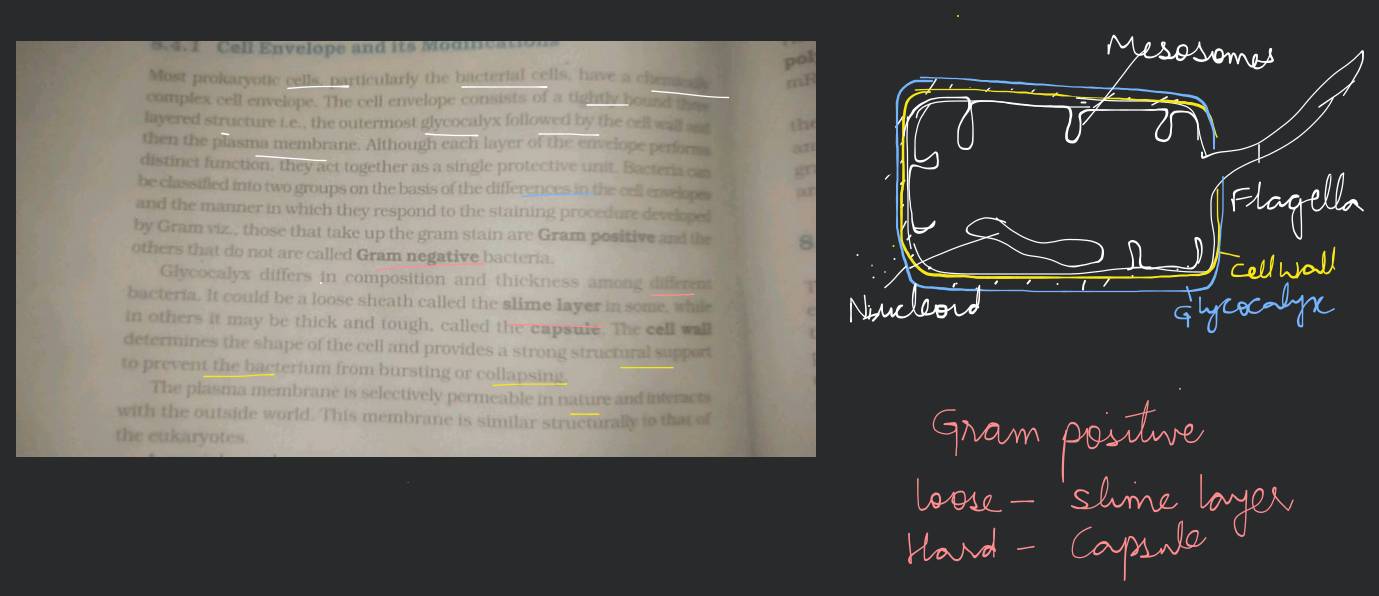Question
Question asked by Filo student

Most prokaryotic cells, particularly the bacterial cells, have a chenticaly complex cell envelope. The cell envelope consists of a tightly bound thes layered structure i.e, the outermost glycocalyx followed by the cell wall ied then the plasma membrane. Although each layer of the emvelope perfomas. distinct function, they act together as a single protective unit. Bacterta con beclassified into two groups on the basis of the differences in the cell envelope and the manner in which they respond to the staining procedure developed by Gram viz, those that take up the gram stain are Gram positive and the others that do not are called Gram negative bacteria. Glycocalys differs in composition and thickness among different bacteria. It could be a loose sheath called the slime layer in some, while in others it may be thick and tough, called the capsule. The cell wall determines the shape of the cell and provides a strong structural support to prevem the bacterium from bursting or collapsing. The plasma membrane is selectively permeable in nature and interacts with the outside world. This membrane is similar struefuraliy to that of the eukriryotes.
Found 2 tutors discussing this question
Discuss this question LIVE
8 mins ago

One destination to cover all your homework and assignment needs
Learn Practice Revision Succeed

Instant 1:1 help, 24x7
60, 000+ Expert tutors

Textbook solutions
Big idea maths, McGraw-Hill Education etc

Essay review
Get expert feedback on your essay

Schedule classes
High dosage tutoring from Dedicated 3 experts
Practice more questions on Cell: Structure and Functions
Question 1
Easy
Views: 5,620
Question 3
Easy
Views: 5,602
Students who ask this question also asked
Question 1
Views: 5,684
Question 2
Views: 5,207
Question 3
Views: 5,459


Stuck on the question or explanation?
Connect with our Biology tutors online and get step by step solution of this question.
231 students are taking LIVE classes
| Question Text | Most prokaryotic cells, particularly the bacterial cells, have a chenticaly complex cell envelope. The cell envelope consists of a tightly bound thes layered structure i.e, the outermost glycocalyx followed by the cell wall ied then the plasma membrane. Although each layer of the emvelope perfomas. distinct function, they act together as a single protective unit. Bacterta con beclassified into two groups on the basis of the differences in the cell envelope and the manner in which they respond to the staining procedure developed by Gram viz, those that take up the gram stain are Gram positive and the others that do not are called Gram negative bacteria.
Glycocalys differs in composition and thickness among different bacteria. It could be a loose sheath called the slime layer in some, while in others it may be thick and tough, called the capsule. The cell wall determines the shape of the cell and provides a strong structural support to prevem the bacterium from bursting or collapsing.
The plasma membrane is selectively permeable in nature and interacts with the outside world. This membrane is similar struefuraliy to that of the eukriryotes.
|
| Updated On | Jul 3, 2023 |
| Topic | Cell: Structure and Functions |
| Subject | Biology |
| Class | Class 11 |
| Answer Type | Video solution: 1 |
| Upvotes | 62 |
| Avg. Video Duration | 4 min |




